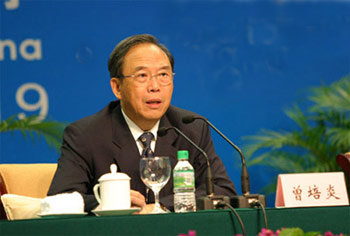| Tools: Save | Print | " target="_blank" class="style1">E-mail | Most Read |
| Western Region Development to Lead Agenda |
| Adjust font size: |
|
Vice-Premier Zeng Peiyan yesterday urged local governments in the country's western region to make "breakthroughs" in infrastructure construction and environmental projects by 2010.
Construction of energy, communications and water conservancy projects will be prioritized, Zeng announced at the opening of the Western Forum of China 2004 in the capital of the Guangxi Zhuang Autonomous Region.
The vice-premier said such projects would lay solid foundations for the further development of the region, which occupies over 70 percent of China's territory and is inhabited by 367 million people.
The region's fragile ecosystem will be greatly improved by that time thanks to the country's efforts to increase grain production and a host of environmental projects, said Zeng.
"A sound infrastructure and environment are not just in the interests of our generation but also of the generations to come," Zeng told the forum, which brings together over 300 representatives from China and abroad, including top government officials, foreign diplomats, business people from western China, overseas investors and economists.
He urged local governments and enterprises to excel in the infrastructure projects which are under way. Meanwhile, planning authorities should conduct feasibility studies and try to come up with new suggestions for projects to be included in the upcoming 11th Five-Year Plan (2006-10).
However, the region has witnessed impressive progress since the central government launched the western development strategy in 1999, especially in the fields of infrastructure and environmental protection.
A total of 850 billion yuan (US$100 billion), of which 400 billion yuan (US$49 billion) came from the central government, was earmarked for water conservation, communications, environmental protection, compulsory education and healthcare over the past five years.
Although ecological and infrastructural progress has been made in the region, it continues to lag behind in terms of technology, education, and in financial and consultancy services.
These are all obstacles preventing capital inflow, said Wang Chunzheng, vice-minister of the National Development and Reform Commission.
"Far away from the coast, investments to inland western areas will cost more in terms of transportation, what's more, the region is facing a market with fiercer competition, which the east usually benefits more from," he said.
He promised long-term and stable financial support for the region, granting more preferential tax rates and flexible policies to encourage non-governmental investment.
Meanwhile, the government remains challenged by pressing problems such as improving farmer's lives, ensuring nine-year compulsory education for children and improving public health facilities in rural areas, said the vice-premier.
The gap between the east and west continues to grow. Statistics show per capita gross domestic product in the west is currently less than half that of the east, and if it grows at an annual rate of 8 percent, the western region will take at least 11 years to catch up.
Zeng was echoed by UN Resident Co-ordinator in China Khalid Malik, who added that the western development strategy should be people-oriented.
He said the strengthened efforts to eliminate poverty were in line with the UN's Millennium Development Goals and more governmental investments in education and healthcare are badly needed.
By the end of last year, China's poverty-stricken population, most of whom live in western China, was thought to be 29 million, down from 250 million before the reform and opening drive started in 1978. But the previous decade has seen a slow-down in the pace of poverty reduction in China.
(China Daily November 19, 2004) |
| Tools: Save | Print | " target="_blank" class="style1">E-mail | Most Read |
 |
| Related Stories |

